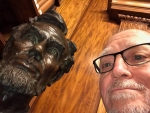To know Shozo Sato was to revere the local artist, director, author, professor and founder of one of the crown jewels of the UI campus — Japan House. As friends and followers celebrate the remarkable life of the pride of Kobe, Japan, who died on May 4, 2025, we asked a few of those who knew him for the best Shozo story.
“My wife, Ceil, and I were traveling with Shozo, fundraising in Japan. Through his connections, he somehow got us on what he described as the ‘Japanese Johnny Carson Show,’ where we talked about Japan House and teaching Japanese art and culture in the middle of Illinois cornfields.
“Years later, I asked him how he got us on that show and he said: ‘It cost me a case of good scotch.’ He was skilled in such an amazing number of traditional Japanese arts that, had Japan been known for a renaissance, he would have been labeled a Renaissance Man.
“I will remember him as a superb teacher, a true gentleman and a good friend.”
“Once, I accompanied Sato-Sensei on a trip to Chicago. When we arrived at the hotel, he parked his car and noticed that there was a long line for the main desk that stretched through the door. ‘We’ll go this way,’ he said, as he pushed open an ‘employees only’ entrance.
“I followed him through back rooms until we reached the kitchen, where the entire staff greeted him with boisterous hellos. He led me through another backroom, and then into the lobby, where the line still waited.
“Someone behind the counter spotted him, ran out from behind the desk, and handed him his key.
“That’s the sort of thing that happened every day you spent with Shozo Sato. He was always scoffing at any suggestion that he couldn’t, because he always could, and he’d make it fun, enriching and beautiful.
“Anywhere he went, everyone in sight got a burst of inspiration when they saw his bold gentility in action. For the last decade, wherever I went in his company, I’d see the folks there spot him coming and their faces brightening into beaming smiles, because they knew they were about to have a Shozo Sato day, and those are packed with adventure and tranquility in equal measure.”
“Shozo Sato is known by so many of his students, colleagues and friends as a deeply philosophical and profound, serious thinker, and he certainly was. However, my favorite side of him and what I will remember is, without a doubt, his playfulness.
“Here is one story that is rather special to me.
“I was at Costco and saw a sushi-shaped squishmallow — one of those big, very soft plushies that were super popular for a while — and when I checked the tag, I saw that its name was ‘Shozo.’
“Of course, I bought it to give to him as a joke, fully expecting him to be rather unimpressed, but when I gave it to him, he had a rather different reaction than I expected: he seemed delighted, hugged it earnestly and kept it sitting next to him the rest of the day, occasionally patting it on the head or acting as if we were talking to Shozo the squishmallow rather than addressing him.
“I am not sure if he was humoring me or just liked the plushie, but either way, it really exemplified how he embodied the wonder-filled, lighthearted spirit that is so often touted as an ideal for which we should strive in the Japanese Way of Tea, which is among the many arts he taught.
“He was not just talking the talk, he walked the walk, so to speak.
“Even though I knew him far fewer years than most of his students and friends, he lived so dynamically and fully and shared so much of his knowledge, experience and passion for life, that I feel like I gained a lifetime of stories from him, and I am proud and grateful to count him among the several great teachers who guided my artistic and academic career and influenced who I am as a person.”
“Japan House was founded on the visionary concept of Professor Emeritus Shozo Sato, a master artist and educator whose profound dedication to the traditional arts of Japan laid the foundation for everything Japan House represents today.
“Arriving in the middle of the cornfields more than 60 years ago, Professor Sato brought ikebana, calligraphy, black ink painting, kabuki theatre and the Way of Tea to generations of students and community members through his tireless teaching, performances, exhibitions and cross-cultural engagement.
“His pioneering work created not only a physical space for the practice and appreciation of Japanese aesthetics, but also a legacy of cultural exchange, respect and artistic excellence that continues to shape Japan House’s mission and impact to this day.
“His legacy will live on through Japan House and in the lives of the thousands of students he taught — each of whom carry his lessons forward to this day.”
“For me, Shozo will always be the legend people spoke of with celebrity-like adulation from the moment my wife, Taya, and I arrived here many years ago, and when I finally met him, I quickly understood why.
“He was, and will continue to be, sui generis.”
“Sato-Sensei truly reflected the spirit of sensei and his contributions to sharing traditional Japanese arts and culture have resonated with generations of students and visitors at Japan House and beyond.
“When we first met, I was an undergraduate student and still quite new to Japan House as an intern. I took a few shodo (Japanese calligraphy) workshops when he had just moved back to Champaign, and although I wasn’t particularly good at it, I enjoyed the warm atmosphere and the profound wisdom he shared on calligraphy technique and the history and culture of shodo.
“As a student, I deeply appreciated how he was able to teach the practical aspects of technique while explaining the cultural significance of why we did everything a particular way. From his experience in kabuki theater and as an artist, he had an eye for the smallest detail and how it fit into a larger picture.
“He encouraged students and visitors to continuously refine and strive for improvement and deeper engagement with the arts — he often said that art is Vitamin C for one’s soul. You can’t take in a lot all at once; instead, you must do so little by little. If you appreciate and practice art, then eventually you can share art with other people and share that encouragement and nourishment.
“I worked as his assistant to help with his shodo and sumi-e classes and learned so much about Zen philosophy and its influence on Japanese art and aesthetics and Asian culture. Despite not being a practitioner of those particular art forms, his teachings helped me gain a better perspective on art and how it affects the world around us.
“He was meticulous and gave each student hands-on attention and tailored critique. I liked watching him walk around the classroom from student to student, where he would ask them, ‘Shall we dance?’ and guide each student in their calligraphy execution by holding their hand. From children to adults, their postures would straighten, they would breathe together, and a beautiful character would appear on the paper.
”It inspired confidence and students were drawn to the active nature of his teaching methods. Sato sensei conceived and literally built the original Japan House to be his stage for teaching; he thrived in a teaching environment.
“Behind the scenes, he taught me about ‘setting the stage’ and how to handle/prepare equipment and items appropriately to create a proper learning environment that would allow students and visitors to be fully immersed in Japanese arts and culture.
”One summer, my younger brother and I worked with sensei to carefully remount the paper on Japan House’s shoji — even though they were quietly in the background and often overlooked, it was important to him to pass on knowledge of proper stewardship for maintaining the cultural space.
“He was a Renaissance man and shared many niche details and insights, which influenced how I manage programming at Japan House to continue to share Japanese arts and culture for future generations.
“Of the many Zen statements he executed on scrolls, the statement that stood out most to me is: ‘Moving a stone with one’s own hands, will move the hearts of others.’”










© 2025 The News-Gazette, All Rights Reserved | 201 Devonshire, Champaign, IL | 217-351-5252 | www.news-gazette.com
